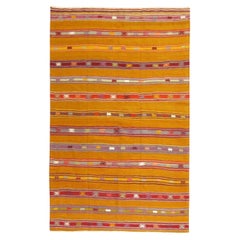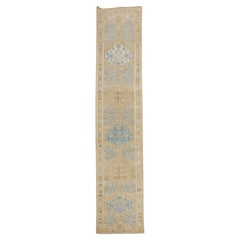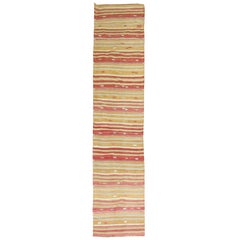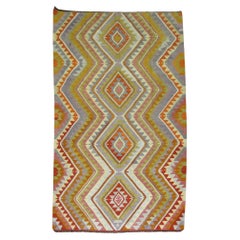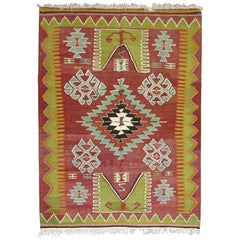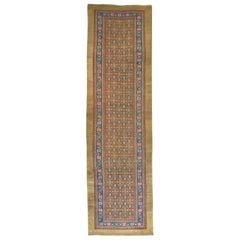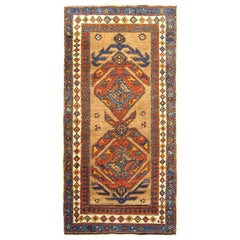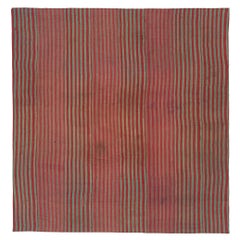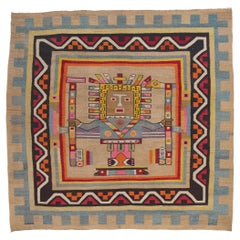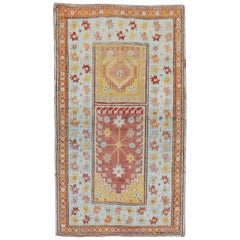Pre-Columbian More Carpets
to
1
Width
to
Length
to
6
4,792
1,179
928
243
145
139
90
89
57
55
49
32
24
20
13
6
6
4
6
6
6
6
6
6
6
6
4
4
2
Style: Pre-Columbian
Zabihi Collection Vintage Turkish Kilim
Located in New York, NY
Colorful mid-20th century Turkish accent size kilim
4'10' x 7'
Category
Mid-20th Century Turkish Pre-Columbian More Carpets
Materials
Wool
Zabihi Collection Vintage Camel Blue Color Persian Runner
Located in New York, NY
A 1940's persian runner in brown and soft blue
Details
rug no. 31469
size 3' x 15' 4" (91 x 467 cm)
Category
20th Century Persian Pre-Columbian More Carpets
Materials
Wool
Vintage Turkish Kilim Runner, 20th Century
Located in New York, NY
A mid century Turkish Kilim runner from the mid-20th century.
Measures: 2'8" x 12'1".
Kilims, primarily refer to a type of flat-woven rug that was produced without knotted pile.
Since this is one of the oldest methods of rug production, it is considered to be primitive...
Category
Mid-20th Century Turkish Pre-Columbian More Carpets
Materials
Wool
Vintage Turkish Kilim 6' x 10'
Located in New York, NY
Colorful mid-20th century Turkish small room size kilim
6'4' x 10'5''
Category
Mid-20th Century Turkish Pre-Columbian More Carpets
Materials
Wool
Vintage Turkish Kilim Throw Piece
Located in New York, NY
Colorful mid-20th century Turkish flat-weave Kilim.
3'11'' x 5'1''
Category
Mid-20th Century Turkish Pre-Columbian More Carpets
Materials
Wool
$900 Sale Price
20% Off
Zabihi Collection Antique Camel Hair Persian Serab Runner
Located in New York, NY
an early 20th century camel hair persian serab runner
3'4'' x 14'2''
Persian Serabs have become very popular decorative rugs in todays market. Designs ...
Category
20th Century Persian Pre-Columbian More Carpets
Materials
Wool
Related Items
Antique Persian Camel Hair Serab Oriental Rug, in Small Runner Size, circa 1900
Located in New York, NY
An antique Persian camel hair Serab oriental rug, size 7'4 x 3'6, circa 1900. The rug is characterized by two interconnected geometric medallions on a camel colored field, enclosed w...
Category
Early 1900s Asian Antique Pre-Columbian More Carpets
Materials
Wool
$4,795
W 42 in L 88 in
Handwoven Vintage Turkish Striped Flatweave Kilim Rug
Located in Dallas, TX
60654 Rustic Vintage Turkish Striped Kilim Rug, 07'03 x 07'06. Step into a world of laid-back luxury and rugged beauty with this handwoven wool distressed vintage Turkish striped Kil...
Category
Late 20th Century Turkish Pre-Columbian More Carpets
Materials
Wool
Vintage Turkish Striped Kilim Rug
Located in Dallas, TX
53114 vintage Turkish Striped Kilim rug. With its warm hues and rugged beauty, this handwoven wool striped kilim rug manages to meld cont...
Category
Late 20th Century Turkish Pre-Columbian More Carpets
Materials
Wool
Vintage Floral Turkish Kilim Rug
Located in Dallas, TX
70271 Vintage Floral Turkish Kilim Rug with Chintz Style and Bessarabian Rose Design, Flat-weave Rose Kilim Rug. Drawing inspiration from Mario Buatta...
Category
Mid-20th Century Turkish Pre-Columbian More Carpets
Materials
Wool
Vintage Turkish Noel Baba Kilim Rug
Located in Dallas, TX
78973-78974 Vintage Turkish Noel Baba Kilim Rug, 03'00 x 03'09. This delightful handwoven wool vintage Turkish Noel Baba Kilim rug brings together the artistry of traditional Turkish weaving and the joyous spirit of holiday folklore. Depicting the beloved figure of Noel Baba, the Turkish equivalent of Santa Claus, this kilim rug adds a charming festive touch to any space. The vibrant colors and playful motifs capture the essence of Baba Noel, a figure rooted in both Turkish and global holiday traditions, who delivers gifts to children and embodies the spirit of generosity and joy during the holiday season.
Noel Baba, a name derived from the French “Pere Noel,” is celebrated across Turkey as a symbol of goodwill and happiness. The kilim rug’s depiction of this cherished figure, with his iconic red suit, white beard, and festive hat, instantly evokes feelings of warmth and celebration. Surrounding him are charming motifs, including trees, human figure, birds, and houses, which are common symbols in Turkish folk art, reflecting a connection to nature and the protection of home and family during the holiday season.
The rug’s composition is framed with bold zigzag sawtooth border, a hallmark of Turkish kilim design, symbolizing protection and continuity. The colorful figures, from Noel Baba himself to the smaller characters representing holiday cheer, are intricately woven, showcasing the craftsmanship and attention to detail typical of Turkish kilim weaving traditions. The playful use of color — reds, greens, blues, and soft neutrals — brings the scene to life, making it a joyful piece for both holiday decor and year-round enjoyment.
This exclusive pair of Baba Noel kilim rugs fit seamlessly into a variety of interior design styles, from Boho Chic to Eclectic and Rustic, bringing a unique blend of Turkish heritage and holiday charm...
Category
Mid-20th Century Turkish Pre-Columbian More Carpets
Materials
Wool
Rustic Vintage Striped Chevron Turkish Kilim Rug
Located in Dallas, TX
50774 distressed Turkish flat-weave Kilim rug with Modern Southwestern boho chic style. With its bold expressive design, incredible detail and texture, this handwoven wool distressed vintage Turkish kilim rug is a captivating vision of woven beauty highlighting modern southwestern boho chic style. The abrashed and weathered field features an all-over geometric pattern composed of repeating bands in alternating colors. The repetitive striped design unites together to form a diamond trellis (lozenge lattice). It is enclosed with a zigzag chevron border?. Though deceptively simple, this vintage Kilim area rug is steeped in Anatolian tradition with a Classic Southern design aesthetic. Step it up a notch and layer over a large jute, sisal, or seagrass rug...
Category
Mid-20th Century Turkish Pre-Columbian More Carpets
Materials
Wool
Vintage Persian Bakhtiari Runner, Traditional Style Hallway Runner
Located in Dallas, TX
75262 Vintage Persian Bakhtiari Runner, Hallway Runner 03'07 X 09'07. This hand-knotted wool vintage Persian Bakhtiari runner features a large-scale Herati pattern composed of serrat...
Category
Mid-20th Century Persian Pre-Columbian More Carpets
Materials
Wool
$1,840 Sale Price
20% Off
W 43 in L 115 in
Vintage Turkish Kilim Flatweave Rug
Located in Dallas, TX
77956 Vintage Turkish Kilim Rug with Tribal Style 05'06 x 10'00. Full of tiny details and a bold expressive design combined with with warm earthy color palette and tribal style, this...
Category
Late 20th Century Turkish Pre-Columbian More Carpets
Materials
Wool
Vintage Turkish Kilim
Located in Lohr, Bavaria, DE
Very fine woven Turkish Kilim, handspun wool.
Category
20th Century Turkish Pre-Columbian More Carpets
Materials
Wool
Vintage Persian Hamadan Runner
Located in Dallas, TX
60184 Vintage Persian Hamadan Runner with Jacobean Style, Hallway Runner. Hand-knotted wool vintage Persian Hamadan carpet runner featuring an all-over geometric design on a saturate...
Category
Mid-20th Century Turkish Pre-Columbian More Carpets
Materials
Wool
Vintage Persian Hamadan Runner
Located in Dallas, TX
61136 Vintage Persian Hamadan runner, 03'04 x 09'11.
With its rugged beauty and rustic sensibility, this hand knotted wool vintage Persian Hamadan runner will take on a curated live...
Category
Mid-20th Century Persian Pre-Columbian More Carpets
Materials
Wool
Distressed Vintage Persian Mahal Runner, Rustic Hallway Runner
Located in Dallas, TX
75196, distressed vintage Persian Mahal runner, rustic hallway runner. A dazzling visual array meets the eye in this distressed vintage Persian Mahal runner. Rustic yet bright and co...
Category
Mid-20th Century Persian Pre-Columbian More Carpets
Materials
Wool
$1,780 Sale Price
20% Off
W 45 in L 103 in
Previously Available Items
Colorful Vintage South American Kilim Rug with Pre-Incan Viracocha Deity
Located in Dallas, TX
78610 Vintage South American Kilim Rug, 06'06 x 06'03. Emulating precolumbian art with incredible detail and texture, this handwoven wool vintage Sout...
Category
Late 20th Century Peruvian Pre-Columbian More Carpets
Materials
Wool
Vintage Turkish Anatolian Prayer Scatter Size Rug
Located in New York, NY
One of a kind decorative vintage Turkish Anatolian prayer rug in warm tones.
Measures: 3'2" x 5'3".
Category
1930s Turkish Vintage Pre-Columbian More Carpets
Materials
Wool
Soft Brown Terracotta Persian Paisley Malayer Rug
Located in New York, NY
Authentic handmade Persian Malayer rug featuring a spiraling boteh paisley design in soft earth tones
Measures: 4'5' x 6'4''.
Category
20th Century Persian Pre-Columbian More Carpets
Materials
Wool
Primitive Gray Floral Mid-20th Century Turkish Anatolian Rug
Located in New York, NY
One of a kind decorative vintage Turkish Anatolian rug with a small repetitive floral design on a gray color ground.
Measures: 4'4" x 7'4".
Category
Mid-20th Century Turkish Pre-Columbian More Carpets
Materials
Wool
Vintage Pink Turkish Rug
Located in New York, NY
One of a kind decorative vintage Turkish Anatolian rug.
Category
Mid-20th Century Turkish Pre-Columbian More Carpets
Materials
Wool
Anatolian Village Throw Rug
Located in New York, NY
One of a kind decorative vintage Turkish Anatolian rug.
Category
Mid-20th Century Turkish Pre-Columbian More Carpets
Materials
Wool
Midcentury Turkish Anatolian Rug
Located in New York, NY
One of a kind decorative vintage Turkish Anatolian rug with a fancy floral all-over design on a muted pink red field.
Measures: 4'8" x 6'6".
Category
Mid-20th Century Turkish Pre-Columbian More Carpets
Materials
Wool
Scatter Size Vintage Turkish Rug
Located in New York, NY
One-of-a-kind decorative vintage Turkish Anatolian rug.
Measures: 2'6'' x 4'8''.
Category
Mid-20th Century Turkish Pre-Columbian More Carpets
Materials
Wool
Anatolian
Located in New York, NY
One of a kind decorative vintage Turkish Anatolian rug.
Category
Mid-20th Century Turkish Pre-Columbian More Carpets
Materials
Wool
Vintage Turkish Prayer Rug
Located in New York, NY
One of a kind decorative vintage Turkish Anatolian prayer rug.
Category
Mid-20th Century Turkish Pre-Columbian More Carpets
Materials
Wool
Vintage Turkish Anatolian Prayer Rug
Located in New York, NY
One of a kind decorative vintage Turkish Anatolian prayer rug.
Category
Mid-20th Century Turkish Pre-Columbian More Carpets
Materials
Wool
Vintage Turkish Kilim Throw Kilim Rug
Located in New York, NY
Colorful early 20th century Turkish flat-weave Kilim.
Category
Early 20th Century Turkish Pre-Columbian More Carpets
Materials
Wool
Pre-columbian more carpets for sale on 1stDibs.
Find a broad range of unique Pre-Columbian more carpets for sale on 1stDibs. Many of these items were first offered in the Late 20th Century, but contemporary artisans have continued to produce works inspired by this style. If you’re looking to add vintage more carpets created in this style to your space, the works available on 1stDibs include rugs and carpets and other home furnishings, frequently crafted with fabric, wool and other materials. If you’re shopping for used Pre-Columbian more carpets made in a specific country, there are Asia, West Asia, and Caucasus pieces for sale on 1stDibs. It’s true that these talented designers have at times inspired knockoffs, but our experienced specialists have partnered with only top vetted sellers to offer authentic pieces that come with a buyer protection guarantee. Prices for more carpets differ depending upon multiple factors, including designer, materials, construction methods, condition and provenance. On 1stDibs, the price for these items starts at $900 and tops out at $7,000 while the average work can sell for $2,650.
Recently Viewed
View AllMore Ways To Browse
Chinese Porcelain Tea Caddy
Chinese Procession
Chinese Screen Soapstone
Chinese Stone Mountain
Chinese Tongzhi
Chinoiserie Panels With Mother Of Pearl
Chrysanthemum Bowl
Chu Dau
Circassian Walnut Furniture
Cizhou Ware
Clam Dish
Claude Home
Coin Cabinet
Collection By Drexel
Collection Display Cases
Commode Desk Antique
Copper Judaica
Counter Top Display Case
